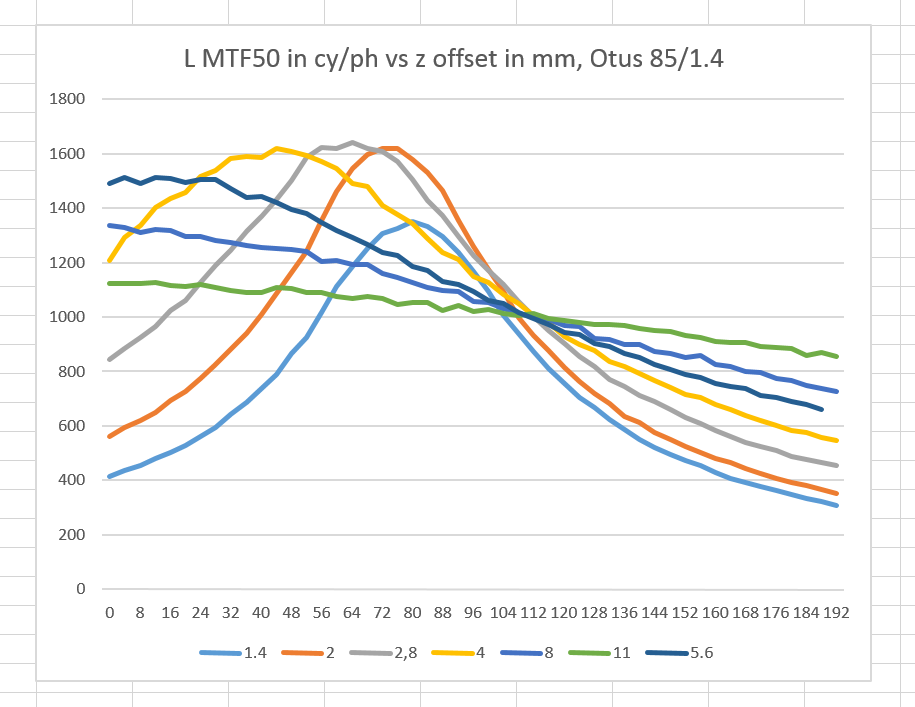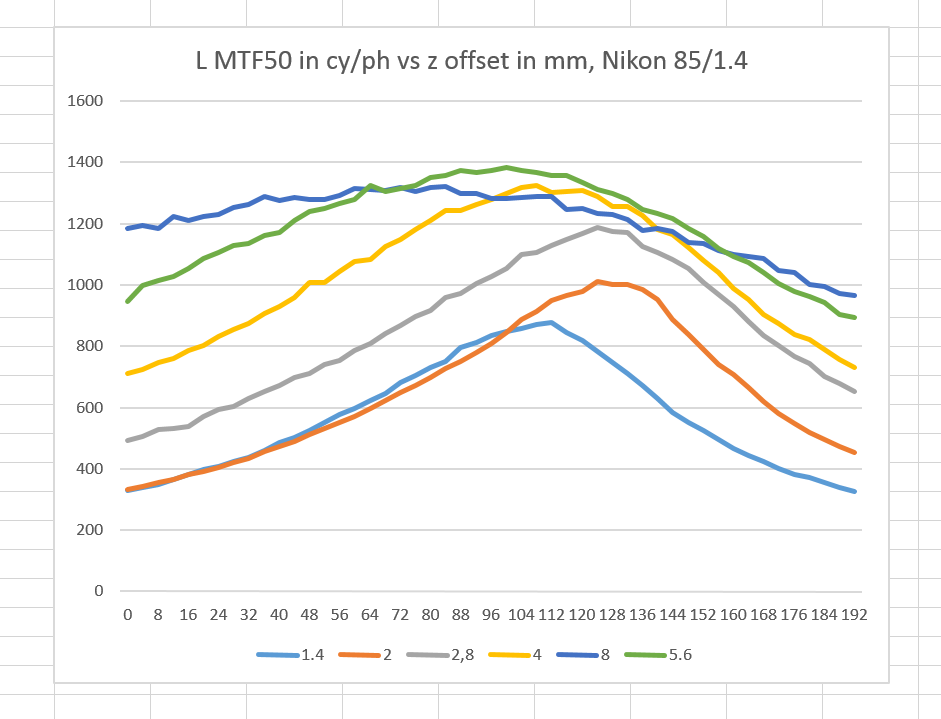This is a continuation of a test of the following lenses on the Sony a7RII:
- Zeiss 85mm f/1.8 Batis.
- Zeiss 85mm f/1.4 Otus.
- Leica 90mm f/2 Apo Summicron-M ASPH.
- AF-S Nikkor 85mm f/1.4 G.
- Sony 90mm f/2.8 FE Macro.
The test starts here.
Yesterday I looked at on-axis focus shift with the Sony 90mm f/2.8 G macro lens and the Zeiss Batis 85mm f/1.8, both on a Sony a7RII, and found a lot of it. Both of these lenses were designed for mirrorless cameras, where focusing is often done at the taking aperture and thus focus shift isn’t as much of a problem as with lenses designed for SLRs, where the focusing is usually done wide open and thus focus shift is more of a problem.
I’m looking at two SLR lenses today, the Otus and Nikkor 85s. Will we see as much focus shift?
I mounted a Sony a7RII to the Cognisys computer-driven focusing rail. I set the controller up to use 192mm of travel and make 49 exposures 4mm apart. I set the assembly 3.3 meters from the target, mounted the lens, focused mid-rail (actually a little toward s the back from mid-rail) and exposed at 49-shot series from 1/1.4 through f/8. For the Otus, I went all the way to f/11. I developed the sets in DCRAW using AHD, and had it convert the files to 16-bit sRGB TIFFs. I told Imatest to calculate the on-axis MTF50 for luminance for a horizontal edge, and plotted the results in cycles per picture height vs distance from the point furthest away from the target.
The Otus:
There is plenty of focus shift; so much that I missed the best focus for the f/8 and f/11 series. The focal point moves away from the subject as the lens is stopped down. We can now see that f/2.8 is the best aperture of on-axis sharpness, which we couldn’t see before I started making these measurements with the motorized rail. To be fair, f/2, 2.8 and 4 are all essentially the same sharpness. It is clear that focusing this lens wide open will not yield optimal results, even at f/8.
The Nikon:
The Nikon is not as sharp. Focus initially moves closer to the subject as the lens is stopped down, then turns around and goes the other way at the transition from f/2.8 to f/4. If you’re going to be shooting at f/5.6 or f/8, it’s probably OK to focus wide open. The Nikon curves are more asymmetrical than the Zeiss ones; I don’t know what that means.
I am surprised by how much focus shift there is with these two lenses. It’s one thing to see it in mirrorless lenses, but entirely something else to see this much shift in SLR lenses.
I am now using the entire length of my focusing rail and still don’t have enough travel to make the curves reliably. I would show you the curves for the Summicron, but the focus shift went away from the f/2 setting as I stopped down, and I missed most of the peaks. The only thing I can think to do about that in the short run is to get closer to the target. However, I think that I’ll find that the inkjet-printed slanted edge target I’m using is not sharp enough for some of these lenses if I do that.
What can be said from results at 10 feet or a little closer about focus shift at other subject distances? At this point, I don’t know.


Wow. I did not expect this.
It means that for critical purposes live view focus stopped down is the go on dslrs. I wonder if Canons dual pixel focus works stopped down? Time for the dslr makers to offer models with EVFs!
Hi,
I think that AF-sensors are optimised for some given aperture, like f/2.8 on some points and f/5.6 on most of them. It probably differs from system to system. So a DSLR may focus at f/2.8 even if the lens is at f/1.4.
I am pretty sure that mirrorless focusing systems combine contrast detect AF and phase detect AF. PDAF for proximity and CDAF for accuracy.
Thanks for sharing fine research, your genius finding simple tests for complex issues never fails to impress!
Best regards
Erik
Thank you for doing theses tests. Focus shift tests are hard to find in any case, and usually only show pictures of a ruler taken at various apertures. What you’re doing here is way more precise and informative. I’m also not aware of any lens manufacturer publishing this kind of information. I think you’re doing a great service to the community by publishing your results.
The results, by the way, are quite disheartening, especially as the Otus does not seem mush better than “lesser” lenses. What’s a focus junkie to do? Stopped down focusing has limits even with the Sony viewfinders. The next generation (Leica SL) will be a bit better, but certainly no panacea. 8×10 and 10x loupe on ground glass? Focus bracketing?
This seems like an interesting way to quantify focus accuracy, either manual or auto. Place the camera in the middle, focus, and then run one of these to see where the actual plane of best focus was.
I agree. AF tests to come. Too bad this testing is so time-consuming, though. And then there’s LoCA testing, which is why I went to this setup in the first place. Fortunately, all the data that I’m using for focus-shift testing can be re-crunched for LoCA testing.
*** off-topic ***
was there a post where one can see after/at which exposure time/duration A7R2 starts some (detectable from the test data) NR (or test otherwise shows at least something going on) for raw data (@ “base” ISO100) ? thank you.
Have a look at this: http://blog.kasson.com/?p=12393
thank you, but the link given is illustrating high ISO and one exposure (1/2000)…
Are you interested in the “star eater” processing in bulb mode?
> Are you interested in the “star eater” processing in bulb mode?
no, no… I was just trying to understand at which maximum exposure time (but still no BULB mode… <= 30 sec really) when I use "base" ISO 100 I still can be more or less sure that there is no detectable manipulations (NR wise) with raw data by Sony camera… so basically did you ever detect any hits of possible NR manipulations @ ISO100 when exposure times are between 1sec and say 10sec (again – no BULB modes and relevant items in Sony menu switched off)… the camera A7R2 (A7R mkII)
I did not.
Is Erik correct in saying with a lens at f1.4 on a DSLR the autofocus “sees” at f2.8?
I am aware the depth of field seen on a DSLR screen is not “real” because of the way the screen screen is made this what is going on?
Are those ripples periodic?
Jack, if you blow it up it looks pretty random, although I haven’t done a Fourier analysis.